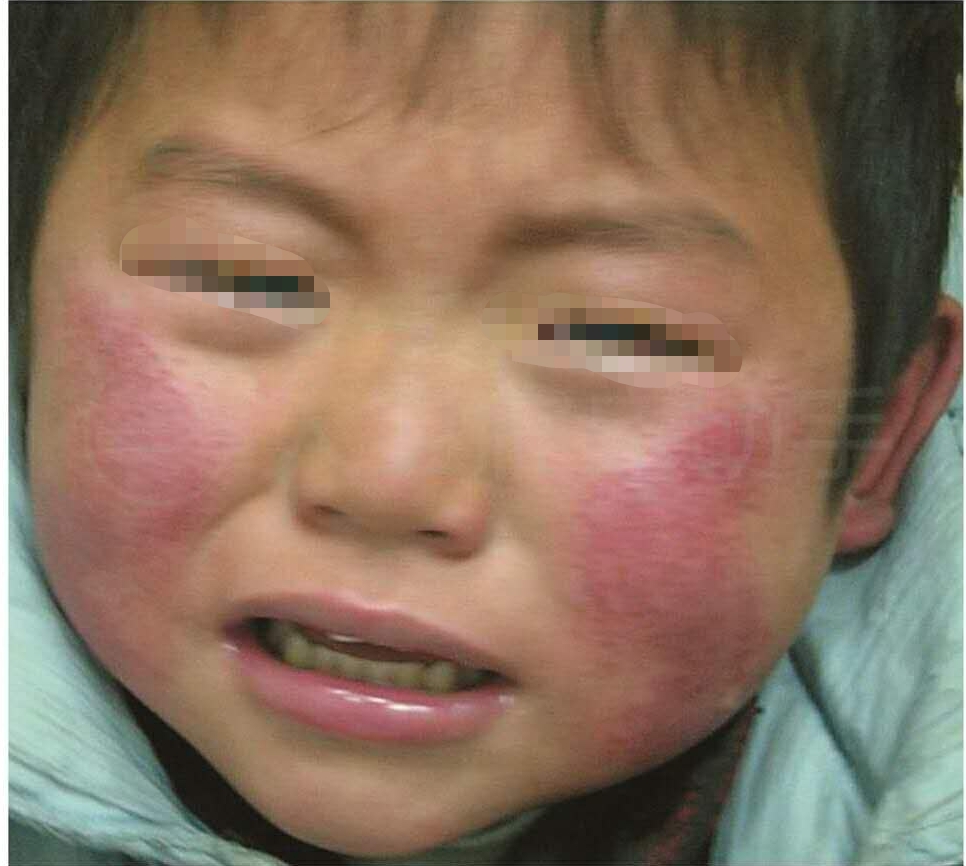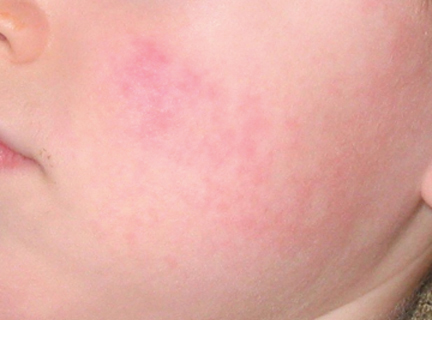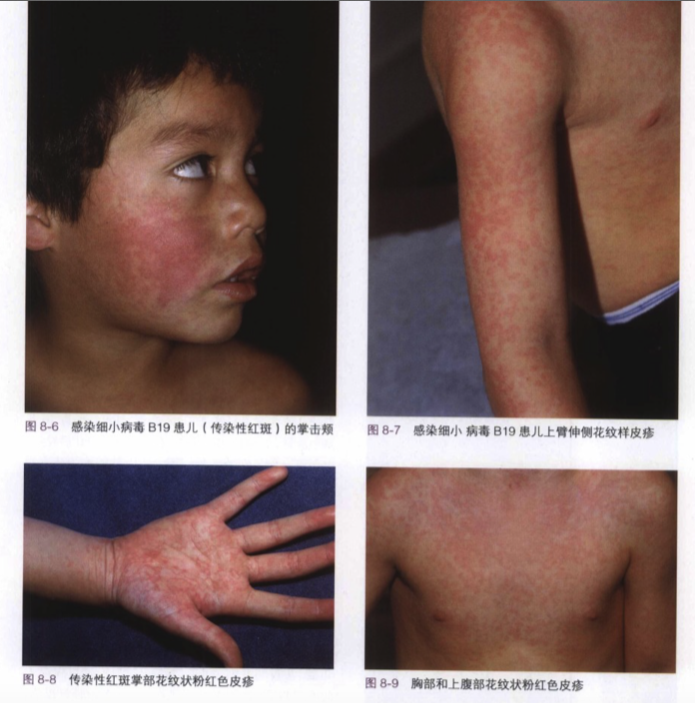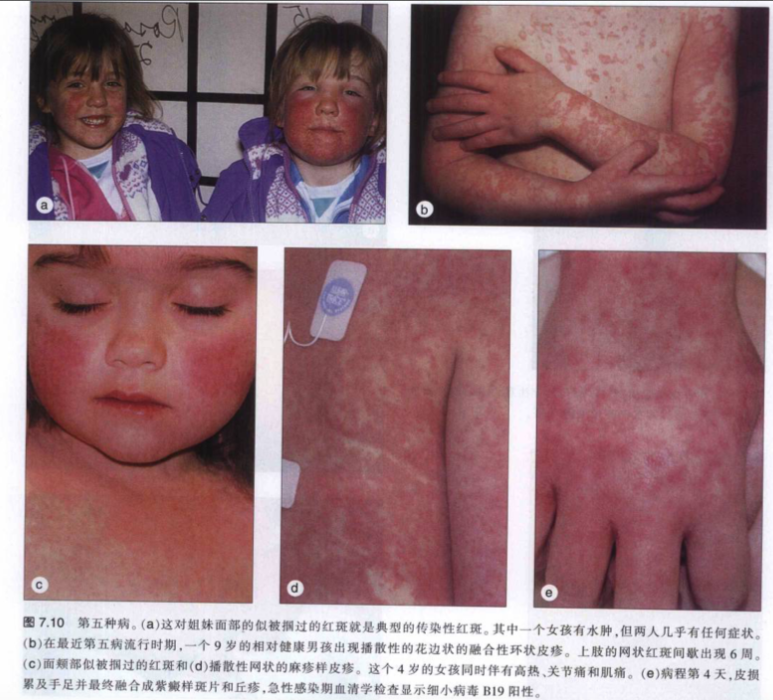Erythema infectiosum
OVERVIEW
What is erythema infectiosum?
Erythema infectiosum (EI) is an exanthematous disease caused by human parvovirus B19 infection, characterized by well-defined rose-red erythema on both cheeks.
It is one of the six common childhood rashes, named in the order they were first reported. Erythema infectiosum ranks fifth, hence it is also called "fifth disease."
There is currently no specific treatment for it. People with normal immune function recover on their own after infection, and the vast majority of affected children have a good prognosis.
Is erythema infectiosum common?
Erythema infectiosum often occurs in outbreaks among school-aged children but can occasionally affect adults. It can occur year-round, with peak incidence in winter and spring.
It is most common in children aged 4–12. If a pregnant woman contracts fifth disease, it can pose risks to the fetus, though this is extremely rare.
Studies have found that the detection rate of antibodies (indicating past infection) increases with age. Approximately 5%–10% of children under 5 years old have B19 antibodies, while the rate in adults is about 40%–60%. This suggests that around 40%–60% of people will experience a B19 virus infection at some point, with erythema infectiosum being a common manifestation.
About 25% of infected individuals remain completely asymptomatic, 50% experience flu-like symptoms such as malaise, myalgia, and fever, and the remaining 25% develop erythema infectiosum and/or arthralgia.
Are contagious dermatitis and erythema infectiosum the same disease?
Erythema infectiosum and contagious dermatitis are two distinct conditions. The former is caused by a viral infection, while the latter is caused by a fungal infection.
Contagious dermatitis, also known as dermatophilosis, is a skin disease caused by *Dermatophilus congolensis*, a fungus primarily transmitted from infected animals.
After skin damage (e.g., prolonged maceration, scratching, abrasions, or insect bites) and contact with infected animals, painless pustules (2–5 mm in size) appear on the hands, arms, or other areas within 2–7 days. These rupture, leaving shallow red ulcers with raised edges resembling a volcanic crater, followed by brown crusts. The crusts fall off after about a week, leaving purplish-red scars. The entire course typically resolves within 14 days.
SYMPTOMS
What are the common manifestations of erythema infectiosum?
The prodromal symptoms are mild and may include low-grade fever, headache, and upper respiratory infection symptoms (such as sore throat, cough, sneezing, muscle aches, etc.).
2–5 days after these symptoms, a rash and/or joint pain may appear:
The typical presentation during the eruptive phase is the appearance of a rash first on the face, giving a "slapped cheek" appearance, with relative pallor around the mouth. The rash may quickly spread to the trunk and limbs, presenting as a lacy, reticulated erythema.
The typical rash usually resolves in about a week but may recur intermittently over several weeks, especially during stress, exercise, sun exposure, bathing, or changes in environmental humidity.




Where does erythema infectiosum commonly occur?
Erythema infectiosum often occurs on the face and may also appear on the trunk and limbs. Only about 10% of children with erythema infectiosum develop joint pain.
How does erythema infectiosum progress?
The prodromal symptoms are mild and may include low-grade fever (only 20% of children experience mild fever), headache, and upper respiratory infection symptoms.
The typical presentation during the eruptive phase is the appearance of a rash first on the face, which then rapidly spreads to the trunk and proximal limbs (i.e., thighs and upper arms), presenting as a lacy, reticulated erythema. The trunk, palms, and toes are less likely to develop a rash.
The typical rash usually resolves in about a week but may recur intermittently over several weeks, especially during stress, exercise, sun exposure, bathing, or changes in environmental humidity.
Patients with joint pain typically recover within 2–4 weeks, though some may experience symptoms for several months.
What severe complications can erythema infectiosum cause?
-
A small number of patients may develop hematologic abnormalities, including reticulocytopenia, decreased hemoglobin concentration, leukopenia, and/or thrombocytopenia. In rare cases, patients with underlying hematologic disorders (such as sickle cell anemia or thalassemia) may experience life-threatening anemia requiring emergency blood transfusion.
-
In very rare cases, B19 virus infection may cause myocardial damage, which can be fatal.
-
Immunocompromised patients may fail to clear viremia, leading to chronic infection, persistent red blood cell system involvement, and chronic severe anemia. Additionally, chronic infection increases the risk of systemic necrotizing vasculitis.
CAUSES
What are the common causes of erythema infectiosum?
Currently, the B19 virus is considered the cause of erythema infectiosum.
Who is commonly affected by erythema infectiosum?
Erythema infectiosum often occurs in outbreaks among school-aged children, mostly between 4 and 12 years old, but it can occasionally affect adults as well.
Is erythema infectiosum contagious? How is it transmitted?
Erythema infectiosum is not highly contagious, but patients with transient aplastic crisis are highly infectious.
B19 virus is contagious 5–10 days after exposure and lasts for about 5 days. During this period, patients may be asymptomatic or exhibit flu-like symptoms.
Subsequently, in immunocompetent patients, the body produces antibodies against the virus, which may lead to specific symptoms or signs such as arthralgia, arthritis, and/or rash.
Once these clinical features appear, the patient is no longer contagious.
Some immunocompromised patients infected with B19 virus may experience prolonged infection and contagiousness. However, there is currently no relevant research on this aspect.
DIAGNOSIS
How is erythema infectiosum diagnosed?
When diagnosing erythema infectiosum, doctors primarily rely on the patient's clinical presentation, medical history, and typical symptoms. Laboratory testing for the pathogen is usually unnecessary for confirmation.
What tests are needed if erythema infectiosum is suspected?
-
For generally healthy individuals without underlying hematologic or immune system abnormalities, laboratory testing is typically not required.
-
For patients with pre-existing hematologic or immune system disorders, a complete blood count (CBC) and reticulocyte count may be necessary. In severe cases or when the clinician requires pathogen confirmation, blood tests for B19 virus IgM and IgG antibodies are performed.
How to interpret test results for erythema infectiosum?
A positive IgM antibody test alongside corresponding clinical symptoms confirms the diagnosis.
IgG antibodies generally indicate past infection, unless a fourfold or greater rise in antibody titer is observed in paired serum samples, suggesting current infection.
Serologic antibody testing may be unreliable in immunocompromised patients. PCR or nucleic acid hybridization can detect viral DNA. However, B19 viral DNA may persist in the blood for 80–100 weeks post-infection, so results should be interpreted cautiously in clinical context.
Are there any precautions before testing for erythema infectiosum?
No special preparation is required for IgM/IgG antibody tests, PCR, or nucleic acid testing. Fasting is unnecessary, as it does not affect accuracy.
What diseases can erythema infectiosum be confused with? How to differentiate them?
The differential diagnosis of B19 virus infection depends mainly on clinical manifestations.
Key conditions to distinguish include other infectious rashes (e.g., roseola, rubella, measles, enterovirus infection, group A streptococcal infection).
The rash's characteristics, distribution, vaccination history, and accompanying symptoms help differentiate these infections.
For patients with pain, acute rheumatoid arthritis must also be considered. Specific tests for rheumatoid arthritis and follow-up are needed, as its symptoms typically persist beyond weeks, unlike B19-associated joint symptoms, which usually resolve spontaneously.
Physicians are best suited to determine the specific diagnosis.
TREATMENT
Which department should I visit for erythema infectiosum?
For children, see a pediatrician. For adults, visit internal medicine or dermatology. Some hospitals have specialized infectious disease or preventive healthcare departments, which are also suitable.
Can erythema infectiosum heal on its own?
Yes, erythema infectiosum is generally self-limiting, with no specific medication required.
How is erythema infectiosum treated?
Erythema infectiosum usually does not require specific treatment and can resolve on its own. For symptomatic relief (e.g., fever, joint pain), oral ibuprofen or acetaminophen may be given. For itchy rashes, topical calamine lotion can be applied.
Patients with complications (e.g., severe anemia) may require blood transfusions, while those with myocardial damage need corresponding supportive care.
Is hospitalization necessary for erythema infectiosum?
Most patients do not require hospitalization. However, those with severe complications (e.g., significant hematologic or myocardial damage) need inpatient monitoring and management.
What are the common adverse effects of medications for erythema infectiosum?
There is no specific treatment for erythema infectiosum. Mild cases typically require no medication.
For fever or joint pain, analgesics (e.g., acetaminophen or ibuprofen) may cause gastrointestinal discomfort, mild hemoglobin decline, or liver dysfunction. Calamine lotion for itching rarely causes adverse effects, though skin allergies may occur (discontinue use if observed).
Can erythema infectiosum be cured completely?
Most patients recover fully. However, those with pre-existing immunodeficiency may develop chronic infection due to persistent viremia.
DIET & LIFESTYLE
What should patients with erythema infectiosum pay attention to in their diet?
Maintain a normal diet with a balanced mix of meat and vegetables for nutritional balance. Avoid foods not previously eaten or those that have caused allergies in the past, as this may complicate determining whether worsening rashes are due to allergies.
What should patients with erythema infectiosum pay attention to in daily life?
Theoretically, early-stage infection requires home isolation, wearing masks, frequent handwashing, and avoiding contact with pregnant women, immunocompromised individuals, or those with hematologic diseases to prevent severe viral transmission.
However, many are diagnosed only after rash symptoms appear, by which time they are no longer contagious.
For fever, prioritize rest and hydration. For joint pain, avoid excessive activity.
Do patients with erythema infectiosum need isolation?
Isolation is necessary during the viremic phase (before rash onset, though diagnosis is often unclear at this stage).
Most studies suggest that by the time rashes appear, the virus is no longer detectable in the blood (viremia has resolved), rendering patients non-contagious, so isolation is typically unnecessary.
Does erythema infectiosum require follow-up? How?
Immunocompetent patients do not require follow-up.
High-risk patients with arthritis, preexisting immune disorders, or hematologic diseases need hospitalization or outpatient follow-up, as determined by their physician.
Can contact with erythema infectiosum patients affect pregnant women?
Patients with active rashes are generally non-contagious; contact is safe.
However, if a pregnant woman was exposed within 15 days *before* the patient’s rash appeared, monitor closely for symptoms (for ~2 weeks) and seek prompt evaluation for fetal health if needed.
What should a pregnant woman do if infected with erythema infectiosum?
No conclusive evidence links B19 virus to congenital abnormalities, but miscarriage risk exists.
No specific treatment is recommended, but regular fetal monitoring is essential. If abnormalities (e.g., hydrops) are detected, delivery should occur in a tertiary hospital with neonatal ICU support.
For severe fetal anemia, intrauterine transfusion may improve survival rates.
How should family members care for a patient with erythema infectiosum?
Ensure adequate rest and a balanced diet to support immune response against the virus.
PREVENTION
Can erythema infectiosum be prevented? How to prevent it?
Erythema infectiosum can be prevented by maintaining hand hygiene, washing hands frequently, avoiding touching the face, eyes, mouth, and nose, and minimizing visits to crowded places, especially during the peak season of the disease in winter and spring. Additionally, reduce contact with sick individuals and avoid sharing food, drinks, or utensils with others.
How to prevent recurrence after recovering from erythema infectiosum?
After infection with the virus causing erythema infectiosum, the body develops antibodies that provide protection against reinfection, so recurrence is generally unlikely.
How can patients with erythema infectiosum minimize its impact on their health?
Currently, there are no effective medical measures to prevent complications of erythema infectiosum. Patients should focus on adequate rest, maintaining a nutritious diet, and supporting a strong immune system to combat the virus.